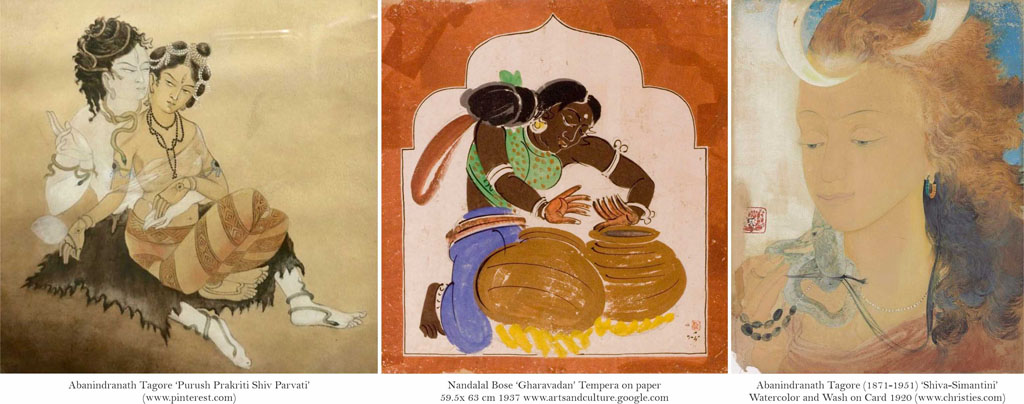Real, naturally, first of all connotes the tangible, existent, factual; and a painting too, first of all, is a visual representation. It is a real object, created by some material residue – charcoal, ink or colours on paper, canvas, etc. though brush, knife or other artistic mediums. The method of application of the medium or ‘technique’ used on a surface is instrumental in developing particular type of texture, inducing ‘value’ or hues in shapes sketched through lines and colours. Lines, colours, shape, value, texture put on space of a given surface are technically called primary elements of a painting, instrumental in creating a composition.
A composition is an opus within which varied combinations and associations of diverse primary elements produce nuances, called the secondary elements of a painting – these could be a movement, a rhythm or dynamics produced by a particular arrangement of the primary elements; or nuances of balance or imbalance, a space illusion or a focal area and so on. This is the making of a painting.
The painting at this point stands as a work of art. The mastery of the medium, which determines visual effect on the canvas, is the criterion to evaluate the formal order of beauty, value and worth of the work. The lack of apparent dexterity required to employ a medium of expression forms a major criterion of condemnation of art in contemporary criticism.
The work of art, considered real, aesthetic object is also evaluated in function of its appropriateness for decoration and for enhancement of the point where it is meant for display or created for any other purpose such as activating psychosomatic upshots in the mind of the audience, as subtext of meditation or for spiritual purposes, education, study of the subject, healing etc. As such, it remains a creation, real and pure, with no intention of fulfilling any purpose other than the function of the moment – the purpose of extracting pure pleasure within the process of creating it and within exercise of displaying or using it as an aesthetic object.
The art noveau and the postmodern critics consider an art work ‘complete’ at this level of construction and perception while exalting the idea of ‘art for art sake’.
To ponder upon the meaning of ‘real’ further in context of painting, it needs to be scrutinised beyond its existence as a mere object of aesthetic value.
It would be interesting to highlight that objects depicted on the canvas are not mere picture of external objects as perceived by the naked eye. They are depictions of the intimate perception of the same by an individual, in the sense that the images depicted on the canvas are arrangements of objects which have passed through the mental world of the artist. They have been ‘seen’ anew, in sense of having been understood, conceived and visualised through various angles of emotion and sensitivity in the mind of an individual depending on his past experiences, knowledge and awareness about those objects. While the objects exist in the mind, they are called ‘unreal objects’ (ref 1).


They may stand alone or in relation with other mind objects as an idea, enjoying a framework of time and space in the mind itself. This is the process of ‘thought’, a feature and facet of human consciousness. Thought process may be an involuntary, perpetual process, or can be in conscious application, wherein an individual gives to the external objects, a new and unique framework of dimensions of space and time in his mind by arranging them in a particular way, depending on subjective perception. This process is the basis of human imagination and is technically called ‘imaginative consciousness’ (ref 2).
A visual artist goes a step ahead to catch the fleeting mental objects by re-creating them as images and objects through material residue like wood, canvas, colours etc. in a new and actual framework of time and space.
The objects depicted by the artist as a work of art, are therefore not mere external objects in the sense of being real, but also hold some deeper reality of the mind of the artist – a perception, an understanding, an emotion etc., surged from his awareness / knowledge about, and sensitivity towards those external objects. It is in this sense that a painting of any style or genre, from plain realism to the apparently most unrecognisable or ambiguous depictions in modern, post modern and contemporary art cannot be considered meaningless or absurd- on the contrary these works hold a deeper reality to ponder upon.
In words of Rabindranath Tagore: “what is art? It is the response of man’s creative soul to the call of the Real”.
At the same time, there remains to consider, a yet another level to the reality of the painting – to extract the ‘real’ in the same, from the fact that a painting becomes more than a subjective creation by an artist and converts into an object in itself, once perceived by the audience.
It is in here, yet another element of painting, the ‘form’, plays the key role.
Form is the upshot of a composition, created by amalgam of all primary and secondary elements mentioned in initial paragraphs of the text. It connotes an immediate idea, revealed by the work of art or idea that is discerned by the audience.


The aesthetic theory of Tagore explicates the ‘form’ of a painting by comparing it to the phenomenon of life in living tissues:
‘Living tissues are composed of various elements like carbon, nitrogen and many other rudiments utterly unlike life, but never life itself. Life is a phenomenon in itself – ‘apart from’ material elements it is composed of. Similarly the form of a work of art has a meaning apart from the various elements used to create it’.
The appearance, emergence, manifestation of the form has been considered a unique phenomenon: just like the artists perceives the eternal truths, objects, events according to their understanding, awareness, and emotions, and reconstruct it into paintings of their own style/genre ; similarly the viewers, in an exaltation of perception, understand a work of art in their own capacity, knowledge, sensitivity and sentimentality, and ‘recreate’ the work of art in their understanding -each giving it a meaning of his own according to own subjective perception and finding the ‘real’ in the same.
This aspect is the basic connection between the artist, artwork and the viewers–In words of Rabindranath Tagore, ‘An artwork is incomplete unless hung on the wall and appreciated by the audience.’
While the artist studies the objective world and illustrates the ‘real’ according to his subjective perception, the viewers, at next level, study the work of art to extract a deeper reality and thus the real in it. This may also outline the importance of a viewer and logic behind the artist ever searching to display art, beyond all commercial aspect involved.
Ref, quotes by Rabindranath Tagore, The English writings of Rabindranath Tagore: a miscellany, The meaning of art, Rabindranath Tagore, Vol III Sahitya Academy, New Delhi
Ref 1, 2: The Psychology of the imagination, Jean Paul Sartre, Routledge / Taylor&Fransis.




